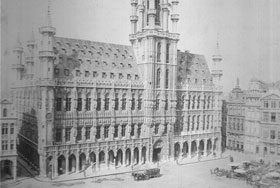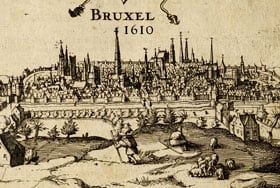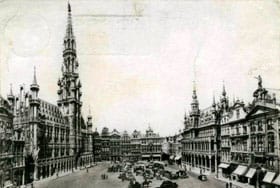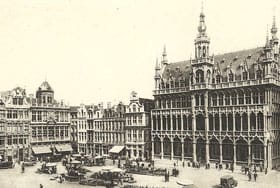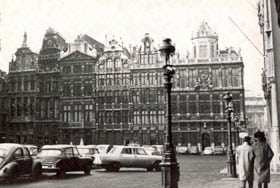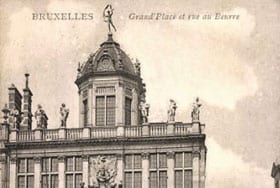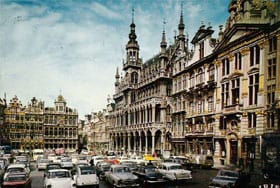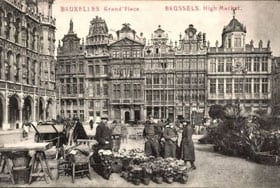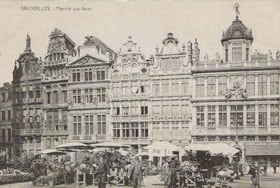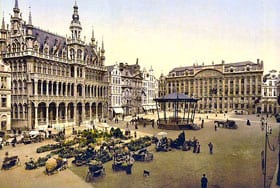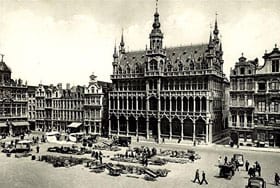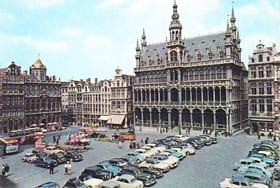Grand Place 1, 1000 Bruxellessales@roydespagne.be+32 (0)2 513 08 07
- LANG.
Le Roy d'Espagne
Le "Roy d’Espagne", built in 1697, was originally the baker’s guild headquarter. It was named after the bust of Charles II which decorates the 2nd floor facade. Charles II was King of Spain in 1697 and sovereign of the southern Netherlands, which then included today’s Belgium. Force, wheat, wind, fire, water and security, all indispensable for bakers, are represented on the front (from left to right) by statues above the balustrades. On the ground floor, above the entrance, Saint-Aubert, patron saint of bakers watches.
This house that suffered during the French revolution has been restored in 1902, as part of the Grand Place’s restoration at the instigation of the burgomaster Charles Buls. After being a cafe and a hardware store, whose gallery remains on the first floor, it regained its cafe vocation in 1952
The Grand'Place
The Grand Place is the central square of Brussels. It is surrounded by opulent guildhalls and two larger edifices, the city's Town Hall, and the Breadhouse building containing the Museum of the City of Brussels. The square is the most important tourist destination and most memorable landmark in Brussels. It measures 68 by 110 metres (223 by 361 ft), and it is a UNESCO World Heritage Site.
In the 10th century, Charles, Duke of Lower Lorraine constructed a fort on Saint-Géry Island, the furthest inland point at which the Senne river was still navigable. This was the seed of what would become Brussels. By the end of the 11th century, an open-air marketplace was set up on a dried-up marsh near the fort that was surrounded by sandbanks. The market was called the Nedermerckt, or Lower Market.
The market likely developed around the same time as the commercial development of Brussels. A document from 1174 mentions a lower market (Latin: forum inferius) not far from the port on the Senne river. The market was well situated along the Causeway (Dutch: Steenweg), an important commercial road which connected the prosperous regions of the Rhineland and the County of Flanders.
At the beginning of the 13th century, three indoor markets were built on the northern edge of the Grand Place; a meat market, a bread market and a cloth market. These buildings, which belonged to the Duke of Brabant, allowed the wares to be showcased even in bad weather, but also allowed the Dukes to keep track of the storage and sale of goods, in order to collect taxes. Other buildings, made of wood or stone, enclosed the Grand Place.
Improvements to the Grand Place from the 14th century onwards would mark the rise in importance of local merchants and tradesmen relative to the nobility. Short on money, the Duke transferred control of mills and commerce to the local authorities. The city of Brussels, as with the neighbouring cities of Mechelen and Leuven constructed a large indoor cloth market to the south of the square. At this point, the square was still haphazardly laid out, and the buildings along the edges had a motley tangle of gardens and irregular additions. The city expropriated and demolished a number of buildings that clogged the Grand Place, and formally defined the edges of the square.
The Brussels City Hall was built on the south side of the square in stages between 1401 and 1455, and made the Grand Place the seat of municipal power. It towers 96 metres (315 ft) high, and is capped by a 4-metre (12 ft) statue of Saint Michael slaying a demon or devil. To counter this symbol of municipal power, from 1504 to 1536 the Duke of Brabant built a large building across from the city hall as symbol of ducal power.[3] It was built on the site of the first cloth and bread markets, which were no longer in use, and it became known as the King's House (Middle Dutch: 's Conincxhuys), although no king has ever lived there. It is currently known as the Maison du roi (King's House) in French, though in Dutch it continues to be called the Broodhuis (Breadhouse), after the market whose place it took. Wealthy merchants and the increasingly powerful guilds of Brussels built houses around the edge of the square.
On August 13, 1695, a 70,000-strong French army under Marshal François de Neufville, duc de Villeroi began a bombardment of Brussels in an effort to draw the League of Augsburg's forces away from their siege on French-held Namur in what is now southern Belgium. The French launched a massive bombardment of the mostly defenseless city centre with cannons and mortars, setting it on fire and flattening the majority of the Grand Place and the surrounding city. Only the stone shell of the town hall and a few fragments of other buildings remained standing. That the town hall survived at all is ironic, as it was the principal target of the artillery fire.
The square was rebuilt in the following four years by the city's guilds. Their efforts were regulated by the city councillors and the Governor of Brussels, who required that their plans be submitted to the authorities for their approval. This helped to deliver a remarkably harmonious layout for the rebuilt Grand Place, despite the ostensibly clashing combination of Gothic, Baroque and Louis XIV styles.
In the late 18th century, revolutionaries sacked the Grand Place, destroying statues of nobility and symbols of Christianity. The guildhalls were seized by the state and sold. The buildings were neglected and left in poor condition, with their façades painted, stuccoed and damaged by pollution. In the late 19th century, mayor Charles Buls had the Grand Place returned to its former splendour, with buildings being reconstructed or restored.
In 1885, the Belgian Labour Party (POB-BWP), the first socialist party in Belgium, was founded during a meeting on the Grand-Place. The Grand Place continued to serve as a market until November 19, 1959, and it is still called the Great Market or Grote Markt in Dutch. Neighbouring streets still reflect the area's origins, named after the sellers of butter, cheese, herring, coal and so on. The Grand Place was named by UNESCO as a World Heritage Site in 1998. One of the houses was owned by the brewers' guild, and is now the home of a brewers' museum.
The Grand Place was voted the most beautiful square in Europe in 2010. A survey by a Dutch website (stedentripper.com) asked its users to rate different squares across Europe. Moscow’s Red Square and the Place Stanislas in Nancy, France, took second and third place.
For banquets, meetings and all other bookings for more than 20 people, please first contact our customer service by clicking here
Please note that your table will be reserved up to 30 minutes after the time you booked. Beyond that time, we will unfortunately no longer be able to guarantee availability unless you notify us of your late arrival before the end of that half hour. Thank you for your understanding.
